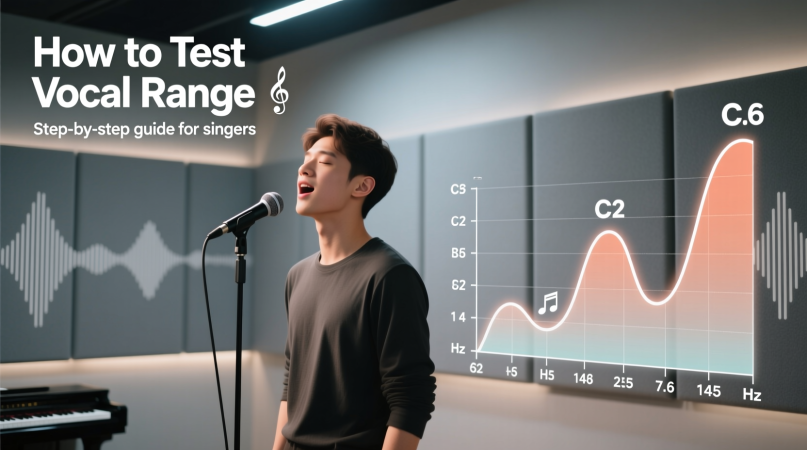
Your vocal range is the span from the lowest note you can sing clearly to the highest note you can reach without strain. Testing it at home only takes a few minutes with a piano, keyboard, or a pitch detection app.
Why Testing Your Vocal Range Matters
Knowing your range helps you:
- Choose songs that fit your voice instead of forcing uncomfortable notes.
- Prevent vocal strain and damage from singing outside your safe zone.
- Understand your voice type (soprano, alto, tenor, baritone, bass).
- Track progress as your singing skills grow.
Use this vocal range calculator to check your range without a piano.
Step 1: Warm Up Your Voice
Before testing, do a light warm-up. A cold voice can give false results. Try:
- Humming or lip trills.
- Gentle scales on “ah” or “oo.”
- A few minutes of relaxed breathing exercises.
Step 2: Find Your Lowest Note
- Start in the middle of your range (a note that feels natural).
- Move down one step at a time on a piano or app.
- Stop when the sound gets fuzzy, airy, or weak.
👉 The last solid note is your lowest pitch.
Step 3: Find Your Highest Note
- Return to your middle range.
- Move upward, step by step.
- Stop when your voice cracks, strains, or loses clarity.
👉 The last comfortable note is your highest pitch.
Step 4: Write Down Your Range
Example: A2 to C5. That equals 2 octaves and a minor third.
Step 5: Compare With Vocal Categories
| Voice Type | Approximate Range |
|---|---|
| Soprano | C4 – C6 |
| Mezzo-Soprano | A3 – A5 |
| Alto (Contralto) | F3 – E5 |
| Tenor | B2 – A4 |
| Baritone | G2 – G4 |
| Bass | E2 – E4 |
This table helps you see where your voice sits, though many singers overlap categories.
Try this free vocal range test to see where your voice fits.
Tools That Make Testing Easier
- Piano or keyboard – most accurate if you know note names.
- Pitch detector apps – show your note in real time.
- Online vocal range tests – quick, beginner-friendly option.
Range vs Tessitura: What’s the Difference?
- Range = the absolute lowest and highest notes you can produce.
- Tessitura = the part of your range where your voice sounds best and feels effortless.
👉 Singers often perform in their tessitura, not their extreme notes.
FAQs About Testing Vocal Range
1. Do I include falsetto in my range?
Yes, if you can sing it clearly. Some teachers count it, others focus only on chest/head voice.
2. How accurate are online range tests?
They’re fairly good for beginners but can misread notes if there’s background noise.
3. How often should I check my range?
Every few months, since training or practice can expand it.
4. Can my range change over time?
Yes. With practice, you may gain a few notes, especially on the top end.
5. Why does my range sound different on different days?
Fatigue, hydration, and even sleep affect your voice.
